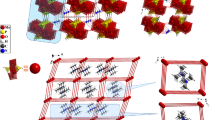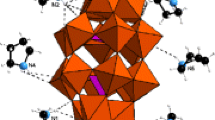Abstract
Large study of theoretical calculations for the hybrid organic-inorganic heteropolyoxometalate (C6H8N)5[HAs2Mo6O26(H2O)]⋅3H2O (1) is reported. The results of theoretical studies, allowed analyzing electronic structure, polarity, electrophilic and nucleophilic reactivity of 1, as well as its flexibility and investigations of thermodynamic properties of 1 were performed. The molecular modelling shows a good reactivity for the compound. The system is an insulator and the high value of its dipole might indicate high polarity of compound. The thermodynamic properties showed a large difference between the variation of enthalpy, entropy and heat capacity energies.





Similar content being viewed by others
REFERENCES
A. Dolbecq, E. Dumas, C. R. Mayer, and P. Mialane, Chem. Rev. 110, 6009 (2010).
A. Bijelic and A. Rompel, Coord. Chem. Rev. (2015)
P. Gouzerh and M. Che, Actual Chim. 298, 9 (2006).
M. T. Pope, Heteropoly and Isopoly Oxometalates (Springer, Berlin, 1983).
M. T. Pope and A. Müller, Polyoxometalates. From Platonic Solids to Anti-Retroviral Activity (Kluwer, Dordrecht, 1994).
M. T. Pope and A. Müller, Polyoxometalate Chemistry. From Topology via Self-Assembly to Applications (Kluwer, Dordrecht, 2001)
J. J. Borrás-Almenar, E. Coronado, A. Müller, and M. Pope, Polyoxometalate Molecular Science (Kluwer, Dordrecht, 2003).
S. F. Jia, X. L. Hao, Y. Y. Ma, et al., J. Coord. Chem. 70, 1156 (2017).
A. Müller, E. Krickerneyer, M. Penk, et al., Angew. Chem. Int. Ed. Engl. 29, 88 (1990).
C. Sun, Y. Li, E. Wang, et al., Inorg. Chem. 46, 1563 (2007).
B. Hedman, Acta Crystallogr. B 36, 2241 (1980).
M. Y. Lee and S. L. Wang, Chem. Mater. 11, 3588 (1999).
Z. Li, R. Cui, B. Liu, et al., J. Mol. Struct. 920, 436 (2009).
J. Zhuang, L. Yan, C. Liu, and Z. Su, J. Inorg. Chem. 2529 (2009).
X. Lopez, C. de Graaf, J. M. Maestre, et al., J. Chem. Theor. Comput. 1, 856 (2005).
H. Liu, N. A. G. Bandeira, V. Félix, and M. J. Calhorda, Eur. J. Inorg. Chem. 1713 (2013).
J. Gracia, J. M. Poblet, J. A. Fernández, et al., Eur. J. Inorg. Chem. 1149 (2006).
C. G. Liu, W. Guan, L. K.Yan, and Z. M. Su, Eur. J. Inorg. Chem. 489 (2011).
W. Guan, G. C. Yang, L. K. Yan, and Z. M. Su, Eur. J. Inorg. Chem. 4179 (2006).
M. M. Rohmer and M. Bénard, J. Clust. Sci. 13, 333 (2002).
C. Sha, Y. Li Kai, S. Ping, et al., Chin. Sci. Bull. 57, 976 (2012).
S. Ping, Y. Li Kai, G. Wei, et al., Chin. Sci. Bull. 54, 203 (2009).
L. Chun Guang, G. Xiao Hui, and S. Zhong Min, Chin. Sci. Bull. 55, 1910 (2012).
F. Liang, G. Wei, Y. Li Kai, et al., Chin. Sci. Bull. 51, 1174 (2008).
Y. Zheng, J. Liu, X. Yang, and J. Wang, J. Mol. Model. 20, 2495 (2014).
S. Cong, L. K. Yan, S. Z. Wen, et al., Theor. Chem. Acc. 130, 1043 (2011).
C. de Graaf, R. Caballol, S. Romo, and J. M. Poblet, Theor. Chem. Acc. 123, 3 (2009).
Y. L. Si, C. G. Liu, E. B. Wang, and Z. M. Su, Theor. Chem. Acc. 122, 217 (2009).
W. Guan, C. G. Liu, P. Song, G. C. Yang, and Z. M. Su, Theor. Chem. Acc. 122, 265 (2009).
S. M. Yue, L. K. Yan, Z. M. Su, et al., J. Coord. Chem. 57, 123 (2004).
F. Li, X. Hu, R. Sa, and L. Niu, Struct. Chem. 25, 539 (2014).
J. Li, J. Clust. Sci. 13, 137 (2002).
A. Harchani, D. Trzybiński, S. Pawlędzio, et al., Acta Crystallogr. C 74, 1088 (2018).
Wavefunction Inc., Spartan 14 (Wavefunction Inc., Irvine, CA 92612, USA, 2014).
Hypercube Inc., Hyperchem 8.0.6 (Hypercube Inc, USA, 2008).
H. Naruke, N. Kajitani, and T. Konya, J. Solid State Chem. 184, 770 (2011).
C. Dey, T. Kundu, H. B. Aiyappa, and R Banerjee, RSC Adv. 5, 2333 (2015).
ACKNOWLEDGMENTS
This work was supported by the Ministry of Higher Education and Scientific Research of Tunisia.
Author information
Authors and Affiliations
Corresponding author
Ethics declarations
The authors declare that they have no conflict of interests.
Supplementary Information
Rights and permissions
About this article
Cite this article
Harchani, A., Haddad, A. Theoretical Study of a Hybrid Organic–Inorganic Heteropolyoxometalate Compound. Crystallogr. Rep. 66, 949–953 (2021). https://doi.org/10.1134/S1063774521060134
Received:
Revised:
Accepted:
Published:
Issue Date:
DOI: https://doi.org/10.1134/S1063774521060134




